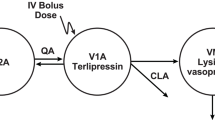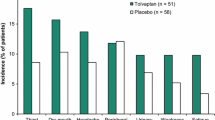Abstract
Objective: To analyse fenoterol-induced tachycardia and hypokalaemia, the most important and most frequent adverse effects of tocolytic therapy with β2-adrenoceptor agonists in females of childbearing age.
Methods:
The study was performed as a double blind, randomised, placebo controlled, cross over trial. Seven healthy women aged 22–38 y, received intravenous infusions of fenoterol at 3 different rates within the therapeutic range for tocolysis (0.5,1.0, and 2.0 μg⋅min−1) and placebo. The time courses of the plasma concentrations of fenoterol and potassium, and the heart rate were analysed with mixed effects pharmacokinetic-pharmacodynamic (PKPD) modeling using NONMEM.
Results:
The plasma concentration-time course followed a linear two compartment model. Fenoterol-induced tachycardia was described by a linear concentration-effect model with baseline. The estimated baseline and slope parameters were 78 beats⋅min−1 and 0.032 beats⋅min−1⋅μg−1⋅l, respectively. Fenoterol-induced hypokalaemia could be described by a physiological indirect response model including feedback; the Estimated basal plasma potassium concentration was 3.93 mmol⋅l−1 and the slope factor for the fenoterol-induced relative increase in the efflux of potassium from the extracellular space was 6.22*10−4 ng⋅l−1.
Conclusion:
The estimated population parameters permitted calculation of the expected time course of tachycardia and hypokalaemia in women after the initiation of tocolysis with fenoterol over the clinically relevant concentration range, and prediction of its variability. Based on simulation, our model predicted that a continous infusion of 2.0 μg⋅min−1 (highest rate examined) would increase heart rate to 113 beats⋅min−1 at steady state and lower the plasma potassium concentration to 2.77 mmol⋅l−1 1.5 h after beginning the infusion. Thereafter, the plasma potassium concentration would slowly return to normal.
Similar content being viewed by others
Author information
Authors and Affiliations
Additional information
Received: 7 December 1995/Accepted in revised form: 29 April 1996
Rights and permissions
About this article
Cite this article
Bouillon, T., Meineke, I., Port, R. et al. Concentration-effect relationship of the positive chronotropic and hypokalaemic effects of fenoterol in healthy women of childbearing age. E J Clin Pharmacol 51, 153–160 (1996). https://doi.org/10.1007/s002280050177
Issue Date:
DOI: https://doi.org/10.1007/s002280050177




